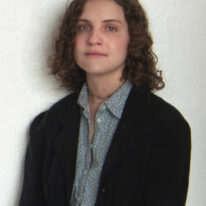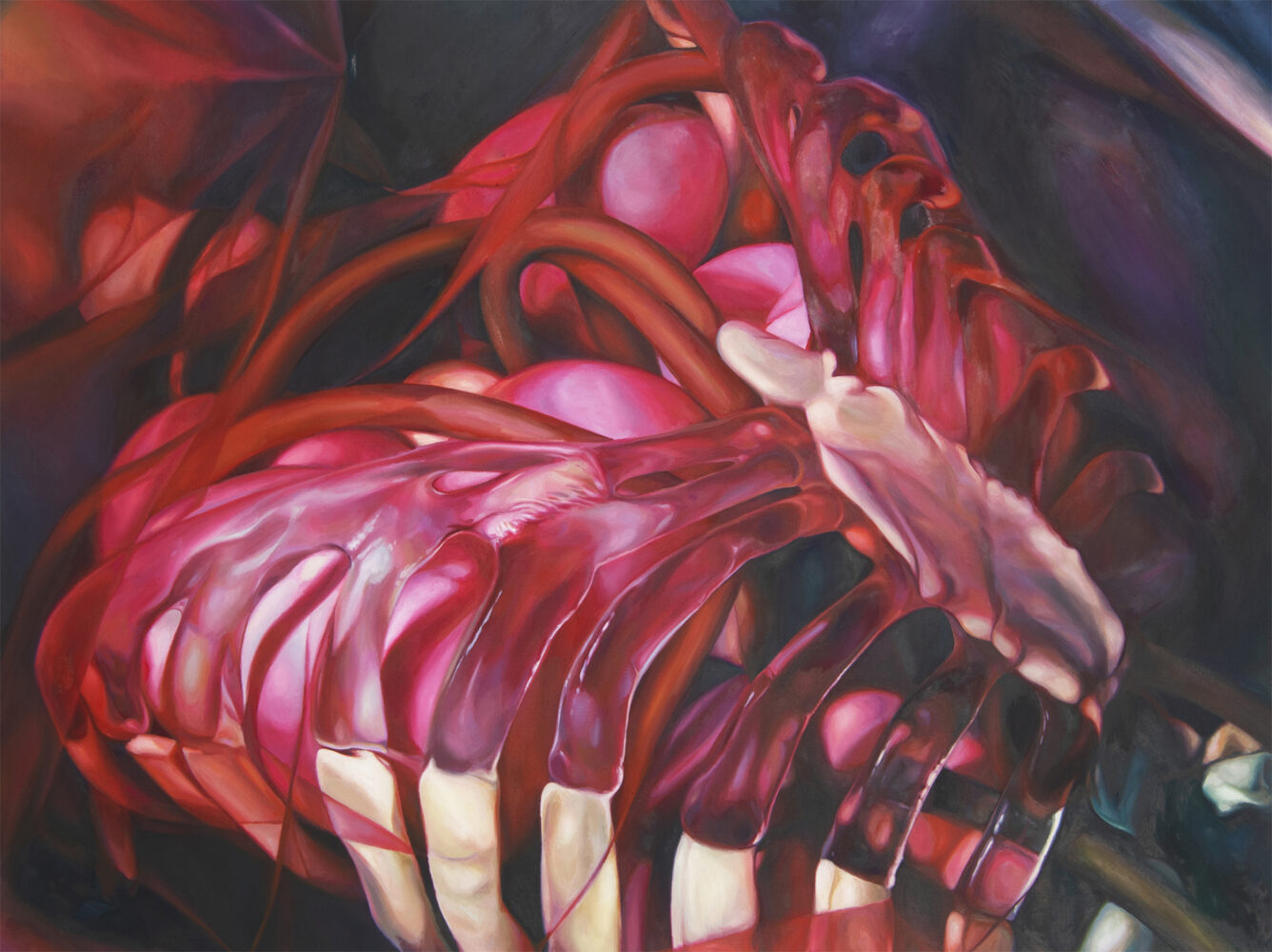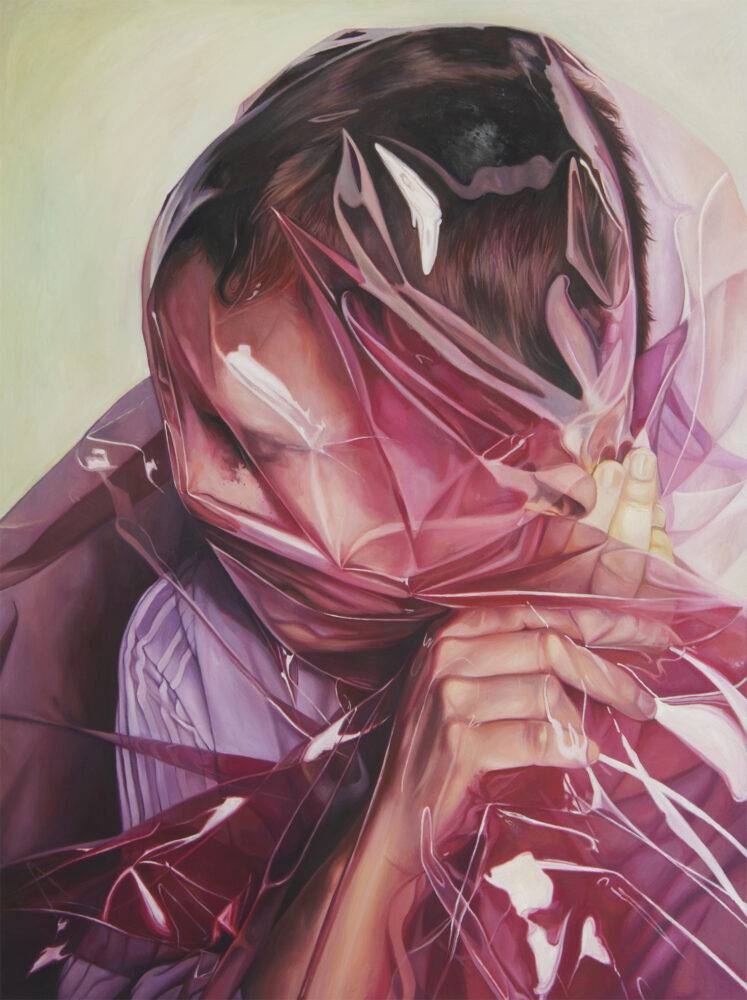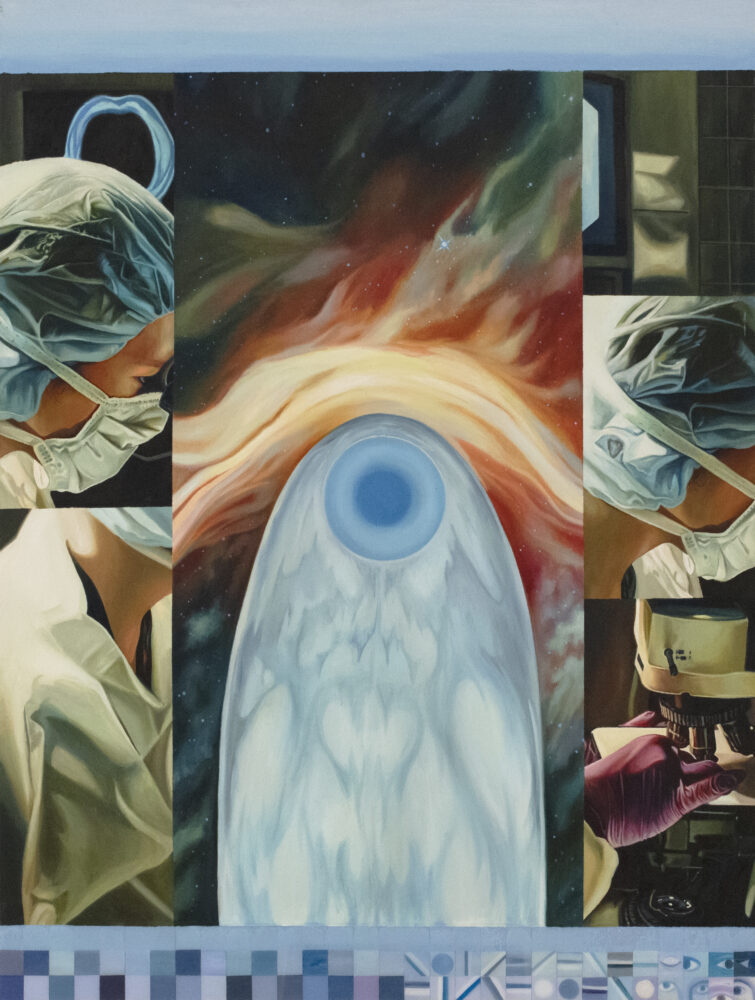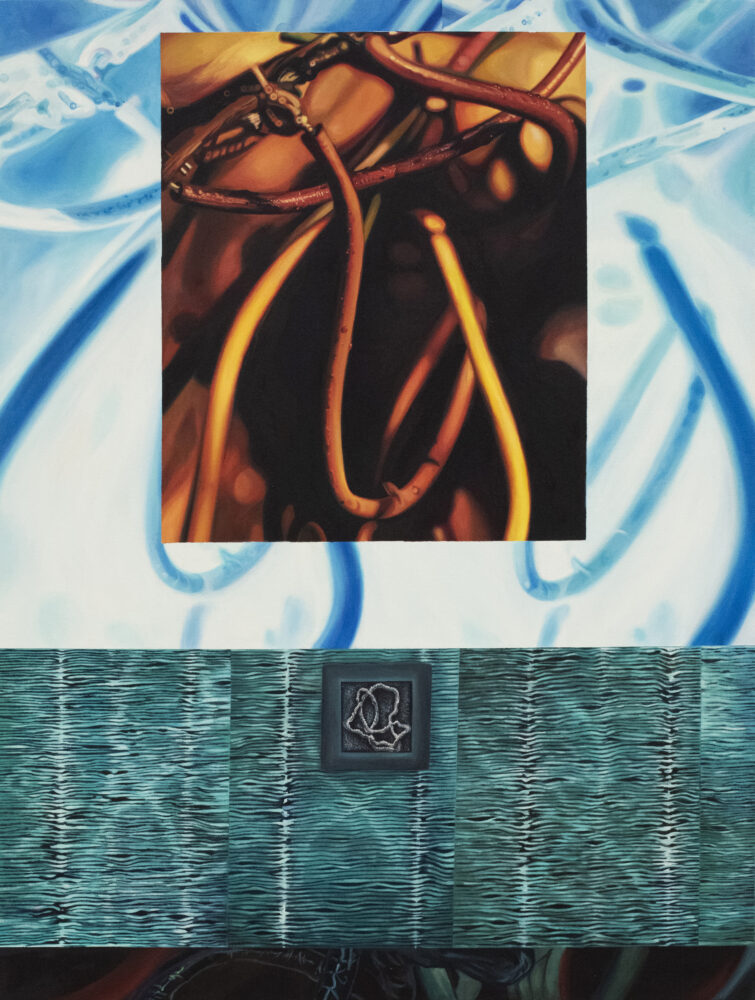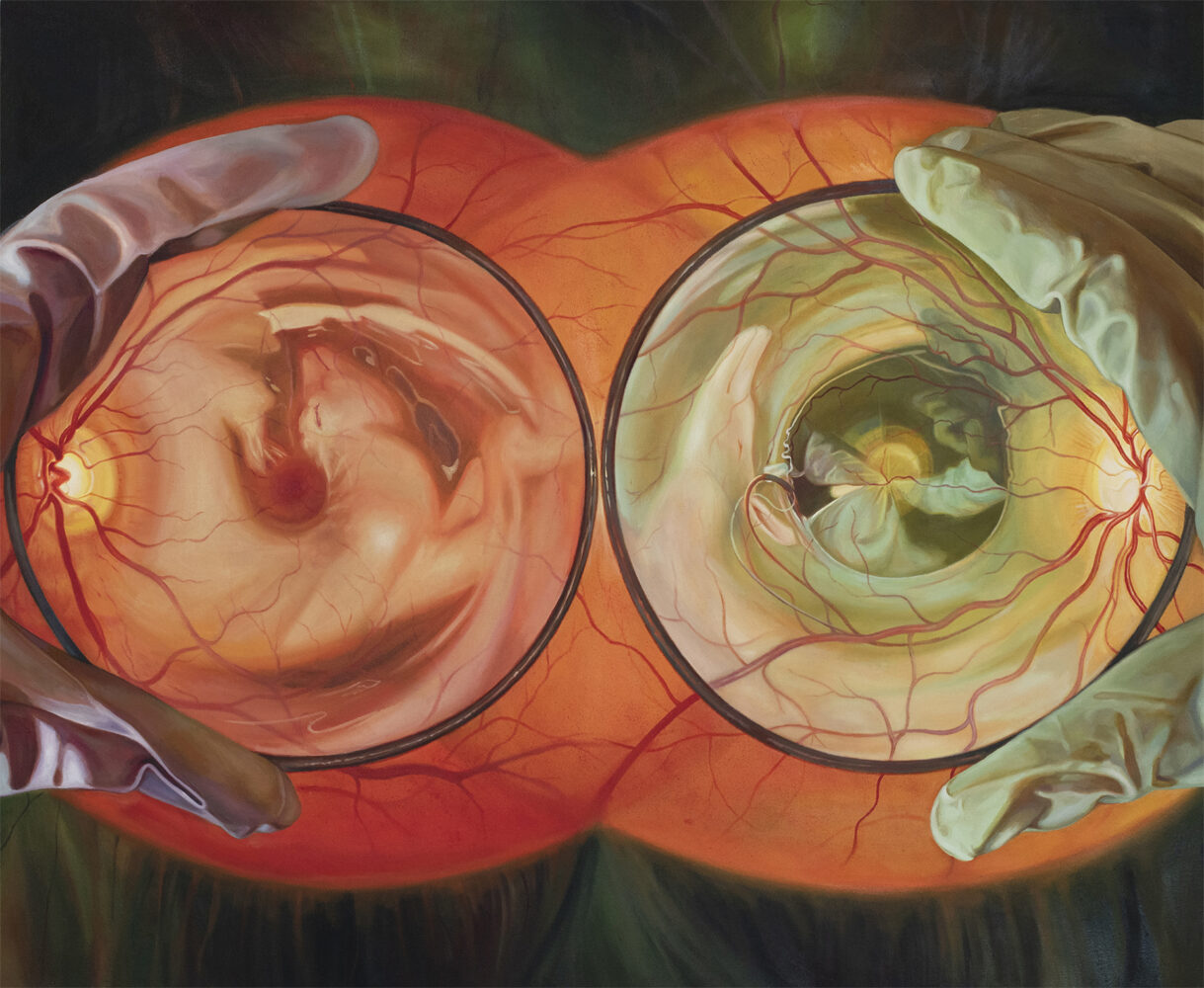Sarah Barnett: “My work stems from conflicting emotions that I’m trying to process and then intuitively find ways to visualize and in a conceptual manner. “

Sarah Elizabeth Barnett is a painter from North Texas, presently living and working in Eastern Washington State. Sarah earned her BFA from the University of North Texas (2018) and attended the 2018 Summer Undergraduate Residency Program (SURP) at the New York Academy of Art. She received her MFA (2022) from Washington State University. Sarah has exhibited nationally and is a 2023 recipient of the Artist Trust Fellowship Award. A devoted oil painter with a background in figure drawing, Sarah’s paintings are highly representational and heavily distorted, with themes revolving around mortality, self-preservation, the human body, and technology. Sarah is currently represented by Gallery110 in Seattle, WA. In addition to her studio practice, she works as a college-level art instructor, private art mentor, and is very involved working with her community as a public arts project manager for a local arts non-profit.
How and why did you start your artistic career?
I began to seriously pursue an artistic career during my time at a residency at the New York Academy of Art, during the summer of 2018. Here, I was given a solid foundation in anatomical figure drawing, painting, and sculpture, as well as crucial, real-world insight into professional studio practices, and the sheer amount of work required. It was also my first time living and working in NY, and I was so inspired, so blown away by the vastness of high caliber artwork and artists surrounding me. It opened my eyes and mind to wholly new possibilities and how I perceived art in general. The experience made me more aware of myself as an aspiring artist, and made me want to push myself, to set bigger goals for my work, my education, my career trajectory, and my overall personal growth. I think it was at this point that I could also better see and nurture my own creative process; the unique way that I see and represent pieces of the world.
How did you discover your medium and why did you choose it?
I discovered a deeper appreciation for oil painting during my undergraduate studies at the University of North Texas, where I graduated in 2018. Before this, I had not enjoyed painting at all, though I was a rigorous drawer since a toddler. Throughout high school and early college, I did many commissioned portraits and pet portraits, mostly in graphite and colored pencil. Blending with colored pencils led me to a love for working with color, which led me to pursue watercolors, and then acrylics and then oils. I was confident in my drawings, but my first university painting class challenged this confidence. The difficulty I found with using oils was initially so frustrating and overwhelming, however, the more I worked through simply feeling the process itself and trying to set aside expectations, the more enjoyable the challenge of painting became. With a lot of patience, I found that the degree of control, depth of color, and the possibilities in blending, application, and in layering were all incredibly rewarding aspects of oils. Painting for me now has become a fulfilling passion, and a meditative and cathartic process.
Can you tell us about your creative process? How does your work come about? How long does it take you to create a work? When do you know it’s over?
Creatively, I draw from interests in anatomy, science, science fiction, film, literature, and Baroque paintings. My work stems from conflicting emotions that I’m trying to process and then intuitively find ways to visualize and in a conceptual manner. My imagery, which is specific yet vague, reflects a deep-rooted fascination and fear I have of the body. Coming from a family with many doctors and nurses, I vividly remember as a young child being completely engrossed in medical textbooks that were around me. Flipping through the pages, I felt a strange mix of intense feelings looking at what should have been the most familiar thing to me, but were instead these beautifully bizarre, grotesque and often frightening images. This experience I know is one root source for my art. Coming from a religious background, this too has made a lasting impact on my work, though more subconsciously. In terms of subject matter, my work reflects on conflicting relationships between humans and technology; about technology’s role in life preservation, mortality, and our desire to make sense of the world. Each of my paintings further explores connections between vision, simulation, the corporeal and the uncanny. Distortion is something that I feel the need to emphasize, and my paintings are kept ambiguous to leave more room for interpretation. Aside from how I physically paint, I do not have a methodology behind creating my images. I do work from a variety of references, including digital collages, photographs, found images, still lifes and sculptures, and collected objects that interest me, such as vintage medical equipment or scientific glass work. For most of my pieces, every element is first constructed with lighting, staging, props, or models, photographed, and then painted. Each painting presents its own challenges in layering, simulating texture, and attempting to convey the right mood. The juxtaposition of my imagery and how I paint it – creating soft or smoothly rendered surfaces, using vivid colors and details – is intended to create tension. This tension is what I want viewers to experience when looking at my work, close up and at a distance. I want this push-pull dynamic to make people think, feel, and question, and to look beyond the illusions themselves. In terms of studio time, I work for several hours most days of the week, and am my most creative late at night. I am currently a college-level instructor and commit my remaining time to my art practice. For the most part, I work very slowly and meticulously. Some pieces take two to three months to complete, but most I finish in about one month. There is no definitive point of completion for me; I decide when I feel it is right and am ready to move onto something new. I’m also forever learning to just trust the process. My studio is where I’m most secure in this, and where I feel belonging. My studio is a space where I can become fully immersed in my mind and feel free.
Who are your favorite artists? Which ones inspire you?
I have always been artistically inspired by Baroque art and paintings of the Dutch golden era, of course, including painters such as Gentileschi, Caravaggio, Rembrandt, and Vermeer. Their use of light and composition to generate intense emotion will always inspire me. My oldest oil works directly quoted these painters’ styles and I studied their work in detail. Some Modern and Contemporary painters that influence me are Jenny Saville, Francis Bacon, Danica Lundy, Lola Gil, Wendelin Wohlgemuth, Jessie Mockrin, and Marilyn Minter. I am also inspired by several interdisciplinary artists exploring the body, art, and technology, such as Mona Hatoum, Hito Steyerl, Trevor Paglan, and Egor Kraft.


